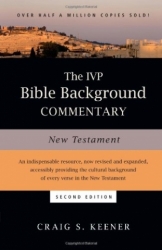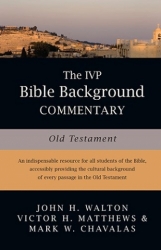The New Testament volume in this Bible Background series has enjoyed a long history of successful sales and use in pastoral and student libraries. Craig Keener first wrote this volume in 1994 and over half a million volumes have been sold. After two decades, Keener has updated his volume to include his further learning and to include some additional documentation. The new volume is just as impressive, and even more helpful than the last.
These volumes are designed to give the reader a window into the historical background of most passages in the Bible. Keener’s volume is more extensive, as you can notice by the similar page count (and of course the New Testament is must shorter than the Old Testament). So not every passage is covered, but if you are studying a chapter anywhere in the Bible there is sure to be plenty of background information on important verses in that chapter. These works are therefore a helpful tool for the student or pastor when preparing sermons, lessons, or papers.
One of the downsides is the lack of documentation throughout the works. This is intentional, since documentation would probably increase the size of the volumes by 50%. But this means one cannot verify the background information given by the authors. To give one example, Ps 68 refers to Yahweh as the “rider in the deserts” and the “rider of the heavens.” Baal’s epithet throughout the Ugaritic corpus is “rider on the clouds,” and “clouds” is only one letter away from “deserts” (arpt and arbt). So most scholars have assumed that the original text of Ps 68 was not “rider in the deserts” (arbt), but “rider on the clouds” (arpt), an epithet taken from Baal and placed on Yahweh. You could then interpret that borrowing as polemical or neutral or as synchronism.
The authors of the Old Testament volume follow much of scholarship by noting that the term is taken from the Ugaritic mythology and applied to Yahweh. However, the “rider” language very clearly comes from Deuteronomy 33 (compare Ps 68: 5, 18, 34-35 with Deut 33:26, 2, 26-27 respectively). As a result, there is likely no direct borrowing in the psalm from Ugaritic mythology, but you wouldn’t know that from reading this volume. You also would not be pointed to the primary sources in the Ugaritic literature to research the issue for yourself. These examples could be multiplied, but the point is that the volumes do suffer from their authoritative bent. That is, claims are made without support, and you are supposed to trust the scholars for their expertise. In most cases, they will of course be correct, but sometimes, such as in the above case, they could be led down a popular, but perhaps incorrect path.
Positively, the volumes include introductions to various sections of the canon. Keener’s introduction to the Gospels, for instance, covers genre (a hotly debated issue) and how to read the Gospels. The Old Testament has an excellent introduction to the psalms. Keener’s introductions are longer and more helpful, in general.
In sum, if you don’t own both of these volumes, you should! They are an excellent quick reference to background information on a passage. Just be sure to always try to check their assertions if you’re able. The primary sources are always king when it comes to background studies.
For a fuller review, with another hermeneutical warning, see my other post at Exegetical Tools.
Buy the books

The IVP Bible Background Commentary: New Testament

The IVP Bible Background Commentary: Old Testament